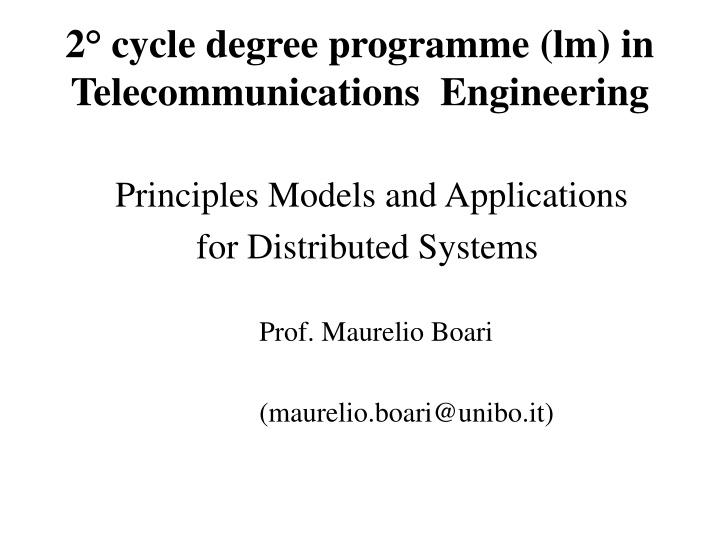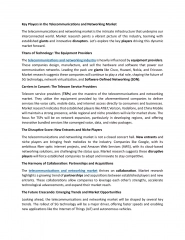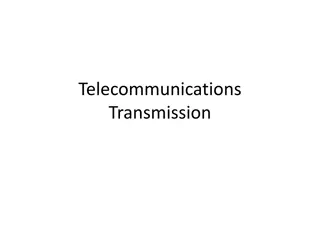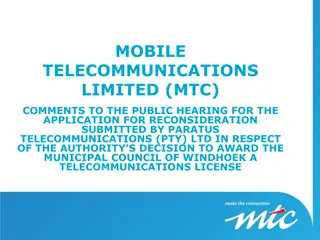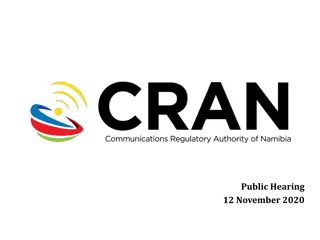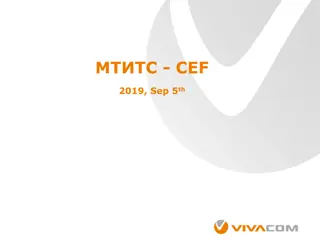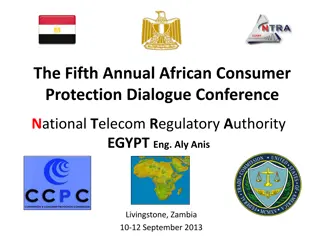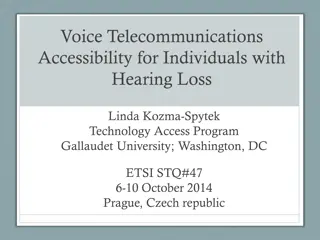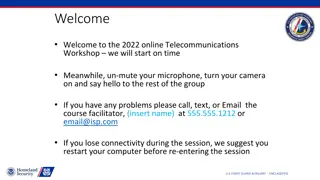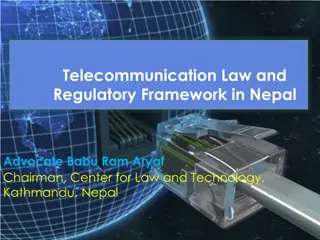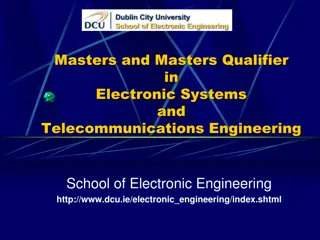Telecommunications Engineering Programme Overview
This programme covers principles, models, and applications for distributed systems in the field of Telecommunications Engineering. Topics include historical recalls, centralized solutions, distributed systems, computer networks, and open systems. Learning outcomes focus on technologies for managing computer networks in complex organizations.
Download Presentation

Please find below an Image/Link to download the presentation.
The content on the website is provided AS IS for your information and personal use only. It may not be sold, licensed, or shared on other websites without obtaining consent from the author.If you encounter any issues during the download, it is possible that the publisher has removed the file from their server.
You are allowed to download the files provided on this website for personal or commercial use, subject to the condition that they are used lawfully. All files are the property of their respective owners.
The content on the website is provided AS IS for your information and personal use only. It may not be sold, licensed, or shared on other websites without obtaining consent from the author.
E N D
Presentation Transcript
2 cycle degree programme (lm) in Telecommunications Engineering Principles Models and Applications for Distributed Systems Prof. Maurelio Boari (maurelio.boari@unibo.it)
Learning outcomes Knowledge related to the technologies needed for management and usage of computer networks
Historical recalls 1960-1970 centralized solutions -Mainframe, passive terminals. -IBM 360- family of computers 360-370-390 (compatible) -5 MHZ, 1MB 2 milions of $ -Univac, Amdhal, Hitachi..( IBM clones compatible) -OS 360, SNA 1980-1990 Mini computers (Digital Equipment Corporation) -PDP 11 ,VAX (DECNET) -UNIX, LINUX 1990 Local networks, Open Systems - Standards (hardware, OS, DBM,TCP/IP .)
Centralized solution (fig.1) TERMINAL TERMINAL centralized computer TERMINAL TERMINAL 4
Fig 2. computer Data Local terminals base 5
Distributed Systems Set of independent computers connected by a communication network in order to execute different functions (administration, management, thecnical problems, logistic, production..) that are present in a complex organization. 6
Computer Network The old model of a single computer serving all the organization s computational needs (fig.1) has been replaced by one in which a large number of separated, but interconnected computers do the job (computer networks) Computer network means an interconnected collection of autonomous computers, that is computers able to exchange information (fig.2).Usually, the nodesof the network are indipendent, each of them with the proper operating system.
Open Systems Distributed systems consisting of eterogenous hardware and software components from different system vendors. Unlike a propritary solution a open distributedsystem can be realized by using components from the different vendors. Utilization of standards (hardware, software) 8
Open systems are computer systems that provide some combination of interoperability, portability, and open standard software. The term was popularized in the early 1980s, mainly to describe systems based on UNIX, especially in contrast to the more complex mainframes and minicomputers in use at that time. Unlike older legacy system, the newer generation of Unix systems featured standardized programming interfaces and peripheral interconnects; third party development of hardware and software was encouraged. A significant departure from the norm of the time, which saw companies such as Amdhal and Hitachi going to court for the right to sell systems and peripherals that were compatible with IBM's mainframes. 9
Standard A technical standard is an established norm or requirement. It is usually a formal document that establishes uniform engineering or technical criteria, methods, processes and practices. Standard de jure: Hardware or software that is endorsed by a standards organization. Standard de facto: Hardware or software that is widely used, but not endorsed by a standards organization The standard concept is relative to the functional aspects of a component; the component may be realized in different ways. 10
Interaction among network computing applications Word wide web application In the past years the www had a very large success basically for two reasons: - Simplicity - Ubiquity For a service provider is simple to contact a great number of users.. For a user is simple to access a service everywhere it is located. However, www is strongly oriented to the interaction among users and systems.
Web limitations The web model is not suitable to the management of the interactions among applications. It is based on a very simple model: - the user, using a browser, sends a URL to a server. - the web server returns a HTML page that is graphically displayed by the browser. In a interaction between two applications this scheme presents two critical aspects: The URL are a very simple tool in order to express complex and articulated requests. HTML is a language basically used to describe how documents may be displayed.
Interaction among network computing applications The evolution of the internet and web utilization made necessary the demand of interactions among applications in different scenarios: A program of business management must be able to integrate the local informations with those made available on Internet by suppliers, banks or public administrations. An application used by estate agents must access real time informations caming from wordwide finantial markets. The library managent system can look for a book either in the local catalog or in those of a larger library management system (University, local goverment, )
Course contents 1.Basic elements of the hardware and software architecture of network nodes. Key words: - Operating Systems, Process, Thread - Multiprogramming, multiprocessing, multithreads - Syncronization
2.System security and network security Key words: - System security, intrusion detection, malicious software, security violation.( viruses,ramsomware, Denial of service..) - Network security, security attacks, criptography ,encryption and decryption, digital signature. - Wireless network security: mobile malware, android security model; iOS security model . - Authentication and access control .
Network Security The security problems in the networks may be subdivided in four cathegories: confidentiality authenticity non repudiation integrity confidentiality : requires that information sent on the network only be accessible for reading to authorized parts. authenticity: requires that it is possible to verify the identity of the subjects involved in the communication. non repudiation : requires that it is impossible to repudiate the sending of a message. integrity : requires that the received message is the same respect to that sent. 16
3. Network applications Key words: - Sockets - RPC and RMI - Client/server and peer-to-peer models - XML language - Cloud computing -Autentication protocols - e-mail security - Security socket layer
Recommended reading W. Stallings: Operating Systems . Prentice Hall, fourth edition ,2001 Douglas Comer : " Computer networs and Internet", Addison-Wesley,2000. . Pfleeger, Pfleeger: " Security in Computing"Prentice Hall, 2004 A.S. Tanenbaum: Computer Networks Prentice Hall, 1996
Seminars Data center and network security Cloud platform Mobile technology and security Big data Internet of things (IOT)
Teaching methods class lessons and lab( Python language, communication tools implementation) Assessment methods oral proof concerning the arguments examined in the course (including Python and tools implementation by Python). Office hours Tuesday, 15-17 (also by e-mail)
